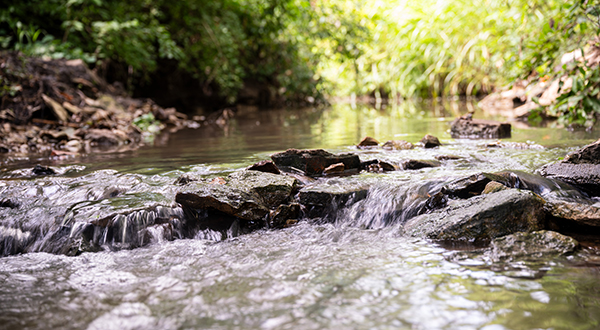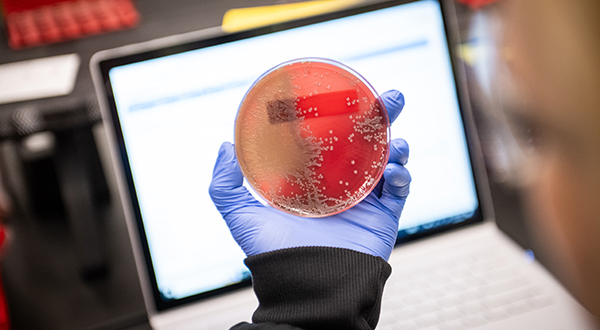Digital twin on the range
Through K‑State 105, Technology Development Institute helps revitalize rural buildings
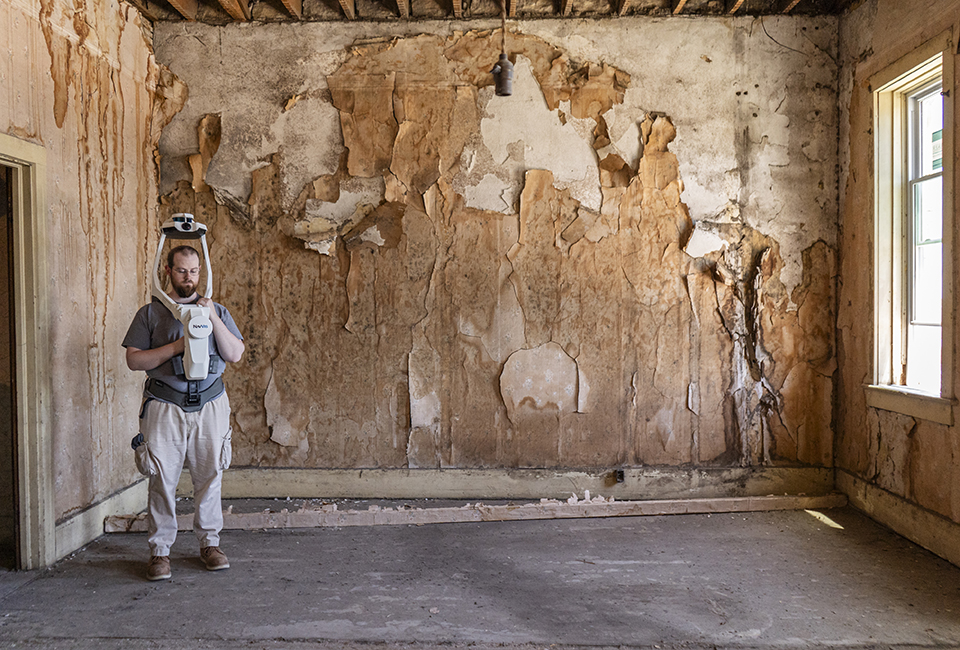 Tom Harris, an engineer with the Technology Development Institute at Kansas State University, straps on the NavVis system and step-by-step scans the second floor of the building in Jetmore, Kansas.
Tom Harris, an engineer with the Technology Development Institute at Kansas State University, straps on the NavVis system and step-by-step scans the second floor of the building in Jetmore, Kansas.
 By Jennifer Tidball
By Jennifer Tidball
K-State 105 and K-State News and Communications Services
You’ll find Lea Ann Seiler’s dream in the windswept prairie of southwest Kansas.
It’s in a building from the year 1884, located on the main street of Jetmore, a town with a population of just under 800 people. It’s the type of charming Kansas town where friendly drivers honk in passing to greet each other, and pedestrians stop to say hello.
Right now, on the street level, the dream looks like a soon-to-be completed retail and coffee shop called Farmhouse Fresh, where Seiler will serve coffee, soups, salads and pastries as well as fresh flowers and retail. The second floor is an old and empty apartment that Seiler hopes to renovate into a living space that could be used by local professionals.
Seiler and her husband Gary have spent eight years working on the space, often encountering unexpected setbacks during the renovation process.
Now they are one step closer.
That’s because Kansas State University research and engagement are helping to make the dream a reality, thanks to the K-State 105 initiative and the Technology Development Institute.
“K-State is making things possible in rural communities, not just for me, but for all the other rural communities that have buildings like this,” said Seiler, also an entrepreneurship manager with NetWork Kansas. “This project would not have happened without K-State 105.”
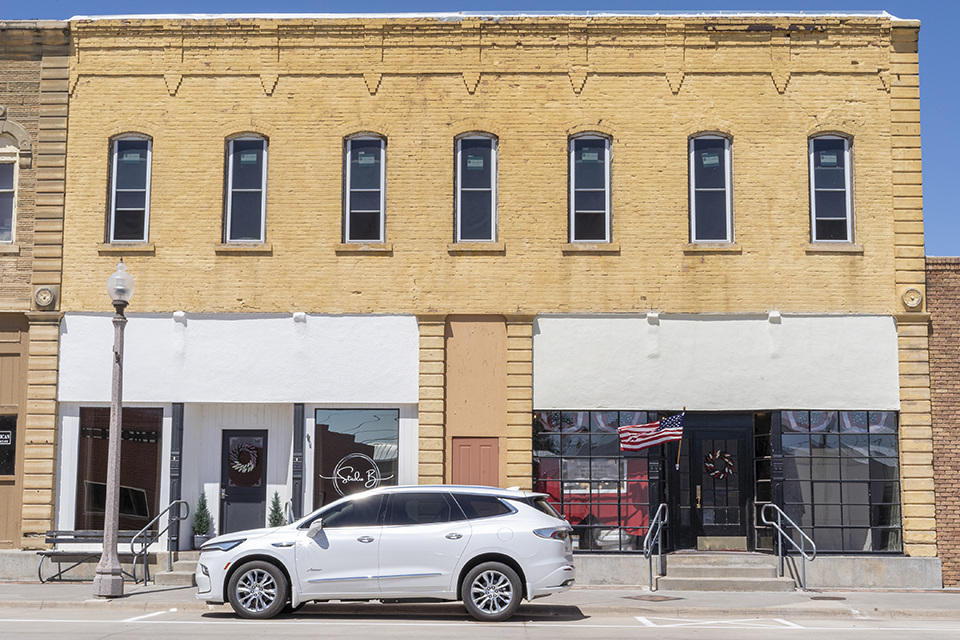 Lea Ann and Gary Seiler are collaborating with TDI as they renovate a building from 1884 on the main street of Jetmore, Kansas.
Lea Ann and Gary Seiler are collaborating with TDI as they renovate a building from 1884 on the main street of Jetmore, Kansas.
Economic prosperity for rural communities
K-State 105 funding has enabled the K-State Technology Development Institute, or TDI, to create a digital twin of the building in Jetmore using a state-of-the-art NavVis scanning system. Seiler will use the digital twin for multiple parts of the renovation, including developing HVAC, electrical and plumbing systems that work together.
The Jetmore building in Hodgeman County is part of a larger K-State 105 project that partners TDI with the Innovation Center in northwest Kansas to use the NavVis system to create digital twins of underutilized buildings that can be provided to developers with dimensionally accurate 3D models of the buildings. This aids in developing plans and cost estimates to put the buildings back into use.
“TDI originally acquired the NavVis system as part of an American Rescue Plan Act grant through the U.S. Economic Development Administration to help manufacturing companies with facility layout and workflow design,” said Bret Lanz, TDI commercialization director. “But through our discussions with economic development officials and housing specialists, we discovered that there was a huge need to repurpose a wide range of buildings in rural communities to help address housing and child care needs.
“While a number of these buildings had been identified, attempting to get architects and developers out to the rural communities to evaluate buildings was nearly impossible,” Lanz added.
And that’s where K-State 105 comes in.
“K-State is making things possible in rural communities, not just for me, but for all the other rural communities that have buildings like this."
K-State 105 is an economic growth and community engagement initiative for all 105 counties in Kansas. The initiative is a key driver of K-State’s Economic Prosperity Plan, and it is a pillar of the Next-Gen K-State strategic plan. K-State 105 has received funding from the Kansas Legislature to collaborate with partners on work that advances economic prosperity in Kansas — work that is happening in communities like Jetmore.
Similarly, the Technology Development Institute in the K-State Carl R. Ice College of Engineering serves entrepreneurs, innovators and manufacturers across Kansas to develop new technologies and products and implement advanced manufacturing technologies.
“We are making the research, resources and expertise of higher education accessible to Kansans in rural and urban communities across the Sunflower State,” said Jessica Gnad, K-State 105 director. “Through its work to create digital twins across Kansas, the K-State Technology Development Institute is an important piece of building economic prosperity in rural communities.”
The TDI digital twin project supported by K-State 105 funding involves more than 16 locations across the state. At these locations, TDI engineers are using the NavVis system to create virtual walk-throughs of buildings.
Now rural communities can contact developers and provide them with a virtual walk-through of the building and a complete, dimensionally accurate 3D digital file of the facility to begin gathering cost estimates of what it would take to repurpose the buildings.
“This is a critical first step in moving projects such as these forward,” Lanz said.
Digital twin creation
On a sunny summer day in Jetmore, Tom Harris, an engineer with TDI, straps on the NavVis system, which looks like a giant white backpack with a camera overhead. He walks up the creaky steps to the second floor and starts scanning the building. Step-by-step, he slowly walks the empty space and captures images, while the NavVis system beeps periodically.
Within an hour, he’s able to pull up an initial 3D scan of the whole floor on a computer screen. After a couple of days of post-processing, the full scan will be available for Seiler to view online as easily as if she were using Google Street View.
Not only can the NavVis system create the ability to virtually walk through the buildings, but it also captures the buildings’ dimensions with up to 5 mm accuracy. The digital twin provides engineers, architects, developers and contractors with building information without having to be on-site — they can view the files in the cloud or download and review the digital model in computer-aided design software, such as Revit or AutoCAD.
“Most rural communities do not have the resources to have someone manually go in and measure out the building and recreate that in AutoCAD, so now they have a 3D model to begin working with,” Lanz said.
In another K-State 105-funded digital twin project, TDI is collaborating with researchers in the College of Health and Human Sciences to scan child care facilities in four locations: Wamego in Pottawatomie County, Phillipsburg in Phillips County, Hillsboro in Marion County and Lewis in Edwards County.
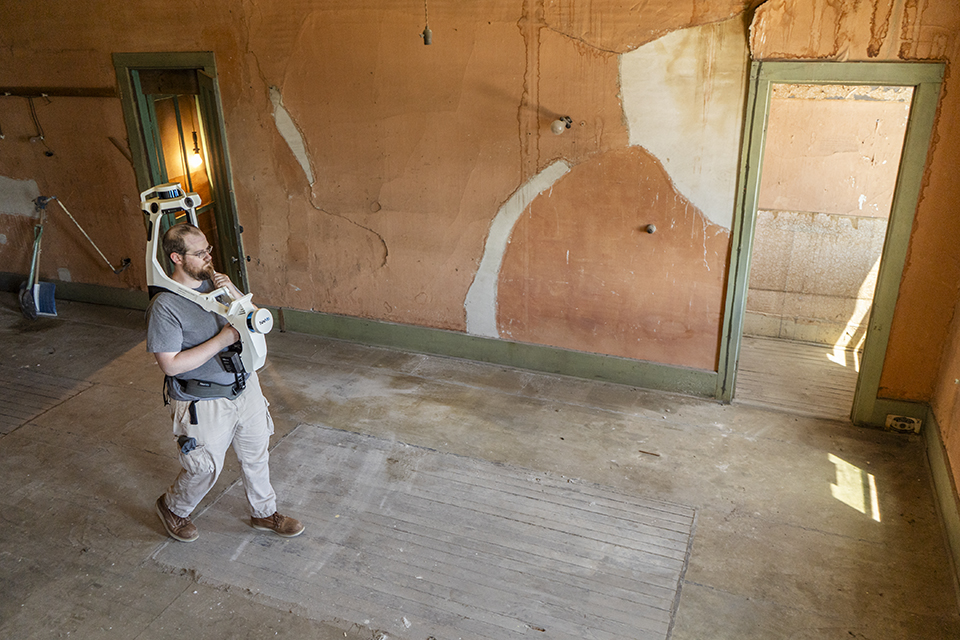 The NavVis system creates ‘digital twins’ of spaces, allowing developers an opportunity to envision new uses for underutilized spaces without having to even visit the buildings in person.
The NavVis system creates ‘digital twins’ of spaces, allowing developers an opportunity to envision new uses for underutilized spaces without having to even visit the buildings in person.
“By taking a closer look at the layout of a building and how the space is being utilized, there are modifications that could be made to the layout to improve child learning and development,” Lanz said.
The institute continues providing scanning services to existing manufacturers who may be looking to expand or wish to evaluate the use of various automation technologies.
TDI also supports the rural housing focus area of K-State 105 by providing scans of rural buildings — abandoned schools, hotels, hospitals or senior care centers that are no longer in use — that could be repurposed for housing expansion in local communities.
Such is the case in rural communities like Jetmore, where Lea Ann Seiler sees the value of TDI’s scanning work helping shuttered spaces — like her dream building in downtown Jetmore — become great places to live.
“Housing is such a big issue in Kansas right now, especially in rural Kansas,” Seiler said. “These buildings that sit empty can be utilized so much better now. It will make a world of difference.”

